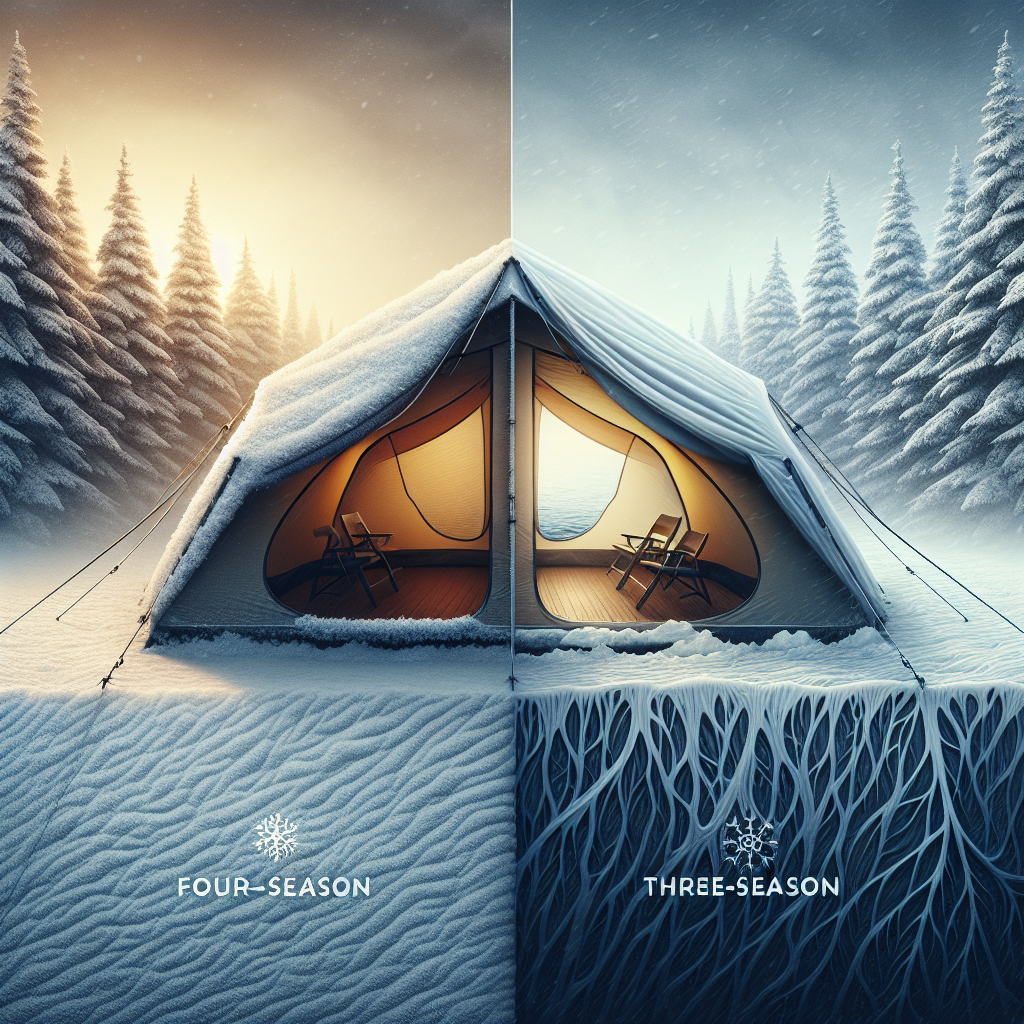Imagine you’re planning a camping trip and deciding which tent to buy. You come across the terms “four-season” and “three-season” tents, but you’re not quite sure what the difference is. Well, let’s clear things up for you! The main distinction between these two types of tents lies in their ability to withstand various weather conditions. A four-season tent is designed to withstand harsh conditions like heavy snowfall and strong winds, while a three-season tent is perfect for mild weather conditions like spring, summer, and fall. So, whether you’re an adventurous soul seeking the thrill of winter camping or someone who enjoys camping in more temperate conditions, understanding the difference between these two types of tents is crucial in choosing the right one for your outdoor escapades.
Fabric and Design
When it comes to choosing a tent, one of the most important factors to consider is the fabric and design. This plays a crucial role in determining the tent’s overall performance, functionality, and durability.
Material
The material used to construct a tent can vary greatly, and it plays a significant role in its performance. Typically, tents are made from nylon or polyester fabrics, which are lightweight, durable, and water-resistant. However, the difference lies in the specific type and quality of the material used. Some tents may use higher-grade materials that offer better strength and longevity, while others may prioritize weight-saving materials without compromising too much durability.
Strength and Durability
The strength and durability of a tent are vital considerations, especially if you plan to use it in rugged or demanding conditions. Four-season tents are designed to withstand harsh weather conditions, such as heavy snow, strong winds, and even alpine environments. They are typically constructed with stronger materials, reinforced seams, and sturdy poles to provide the required stability and support.
On the other hand, three-season tents are designed for milder climate conditions, such as spring, summer, and fall. While they may still be made from durable materials, they are not built to withstand the extreme conditions that four-season tents are specifically designed for.
Weather Resistance
Another crucial aspect of fabric and design is the weather resistance of the tent. Four-season tents excel in this area, as they are specifically engineered to provide maximum protection against harsh weather elements. They often feature a higher water resistance rating, reinforced rainfly, and robust construction to fend off heavy rain and snowfall.
Three-season tents, while still offering good weather resistance, are more suitable for moderate weather conditions. They provide adequate protection against light rains and wind, but they may not hold up as well under extreme weather conditions.
Temperature
The temperature inside the tent is a significant factor to consider, especially if you plan to camp or hike in varying climates.
Insulation
Four-season tents are designed with insulation in mind to provide a comfortable environment even in freezing temperatures. They often have additional layers and materials that help retain heat, ensuring that the tent’s interior remains warm and cozy. Some four-season tents even feature integrated insulation, such as removable liners or thermal barriers, to enhance their temperature-regulating capabilities.
In contrast, three-season tents prioritize ventilation over insulation. They are built to provide ample airflow to prevent the interior from becoming stuffy during warmer seasons. While they may still retain some heat, they are not as effective as four-season tents in extreme cold.
Ventilation
Ventilation is crucial to prevent condensation build-up inside the tent and maintain a comfortable atmosphere. Three-season tents typically feature larger mesh panels, multiple windows, and vents strategically placed to encourage airflow. This helps to minimize condensation and keep the interior cool during warmer weather conditions.
Four-season tents, while they may also have ventilation features, prioritize insulation over ventilation. They tend to have smaller mesh panels and fewer vents to reduce heat loss during colder weather.
Weight and Packability
The weight and packability of a tent are essential factors to consider, especially if you plan to carry it on long hiking trips or expeditions.
Weight
Four-season tents are generally heavier due to their robust construction and additional insulation materials. They are designed to withstand extreme conditions, which often demands sturdier and more durable components. While modern advancements have made them lighter compared to their predecessors, they still tend to be heavier than three-season tents.
In contrast, three-season tents are significantly lighter and more suitable for backpackers and hikers who prioritize weight reduction. They are constructed with lighter materials and fewer reinforcements, making them easier to carry over long distances.
Compactness
Packability is another area where three-season tents excel. Their lightweight construction allows them to be easily folded and rolled into compact sizes, occupying minimal space in your backpack. This makes them ideal for backpackers and hikers who need to save as much space and weight as possible.
On the other hand, four-season tents tend to be bulkier and may require additional space in your pack or gear storage. Their sturdy poles, additional layers, and insulation materials make them less compressible, limiting their packability to some extent.
Seasonal Suitability
The seasonal suitability of a tent is crucial in determining its optimal usage and performance in different weather conditions.
Three-Season Tents
Three-season tents are designed for use in spring, summer, and fall. They are specifically engineered to provide adequate protection from rain, wind, and light snowfall. These tents offer excellent breathability and ventilation, keeping you cool even in the warmest summer days. However, they may not provide the same level of insulation and protection required for winter camping or extreme weather conditions.
Four-Season Tents
Four-season tents are built to handle more severe weather conditions, including heavy snow, strong winds, and low temperatures. They are designed to withstand the harsh elements of winter and can provide insulation and protection against freezing temperatures. These tents are suitable for camping in extreme climates or high-altitude mountaineering, where the conditions demand the utmost durability and stability.
Versatility
The versatility of a tent is another important consideration, as it determines the range of activities and environments it can be effectively used in.
Versatility of Three-Season Tents
Three-season tents excel in versatility, as they can be comfortably used in a wide range of weather conditions. While they may not be suitable for intense winter camping or mountaineering, these tents are perfect for camping trips, hiking adventures, and backpacking in various seasons. Their lightweight construction, excellent ventilation, and weather resistance make them a popular choice for outdoor enthusiasts seeking flexibility.
Versatility of Four-Season Tents
Four-season tents, while more specialized in comparison, still offer versatility in certain scenarios. They are designed for extreme weather conditions and perform exceptionally well in winter camping, mountaineering, and expeditions. These tents are ideal for adventurers who frequently venture into alpine environments or engage in winter expeditions, where their robustness and insulation capabilities are essential.
Intended Use
Considering your intended use for the tent is vital in making the right purchasing decision that aligns with your specific needs and activities.
Camping and Hiking
If you primarily engage in camping trips and backpacking adventures during milder seasons, a three-season tent is likely the best option for you. Its lightweight construction, excellent ventilation, and weather resistance provide the perfect balance between comfort and durability. These tents are suitable for a variety of locations and activities, making them a versatile choice for camping and hiking enthusiasts.
Mountaineering and Winter Expeditions
For those who seek to conquer more extreme environments, such as high-altitude mountaineering or winter expeditions, a four-season tent is essential. These tents are designed to tackle the harshest weather conditions and provide the necessary protection and insulation required in such extreme environments. Their durability and stability can make all the difference in ensuring your safety and comfort during challenging expeditions.
Price
Price is often a significant factor when purchasing a tent, and it can vary greatly depending on the quality, features, and brand. Four-season tents, with their specialized construction and materials, tend to be more expensive than three-season tents. However, before making a decision based solely on price, carefully consider your specific needs, intended use, and the value you place on features such as durability, weather resistance, and insulation.
Conclusion
When choosing between a four-season and three-season tent, it’s crucial to assess your specific needs and activities. Four-season tents provide the highest level of durability, insulation, and protection against extreme weather conditions, making them ideal for mountaineering and winter expeditions. On the other hand, three-season tents offer versatility, lightweight construction, and excellent ventilation, making them suitable for camping, hiking, and backpacking in various seasons. Ultimately, the decision should be based on your intended use, location, and the level of comfort and durability you seek from your tent. Consider factors such as fabric and design, temperature regulation, weight, packability, and seasonal suitability to make an informed choice that enhances your outdoor experience.

